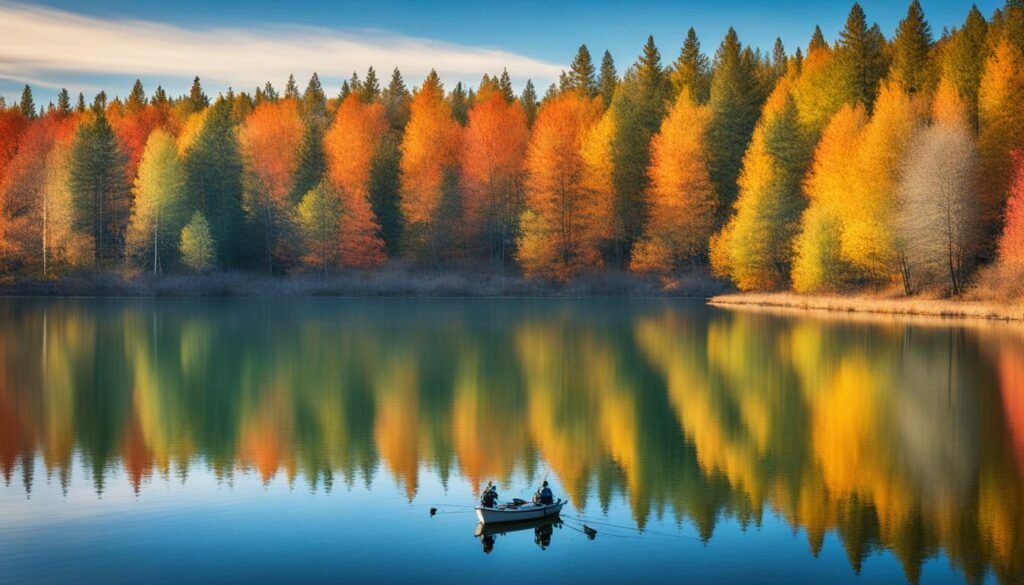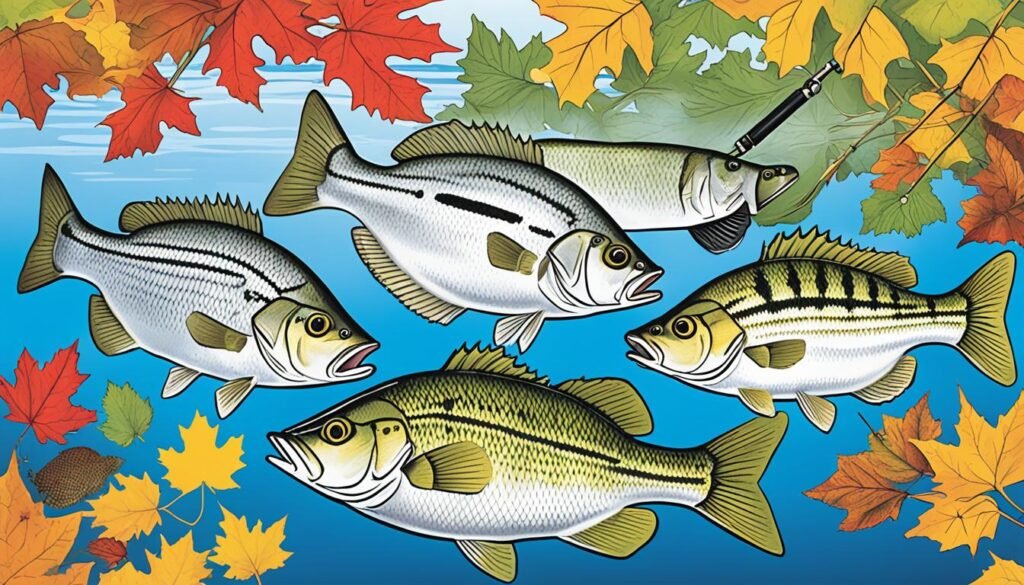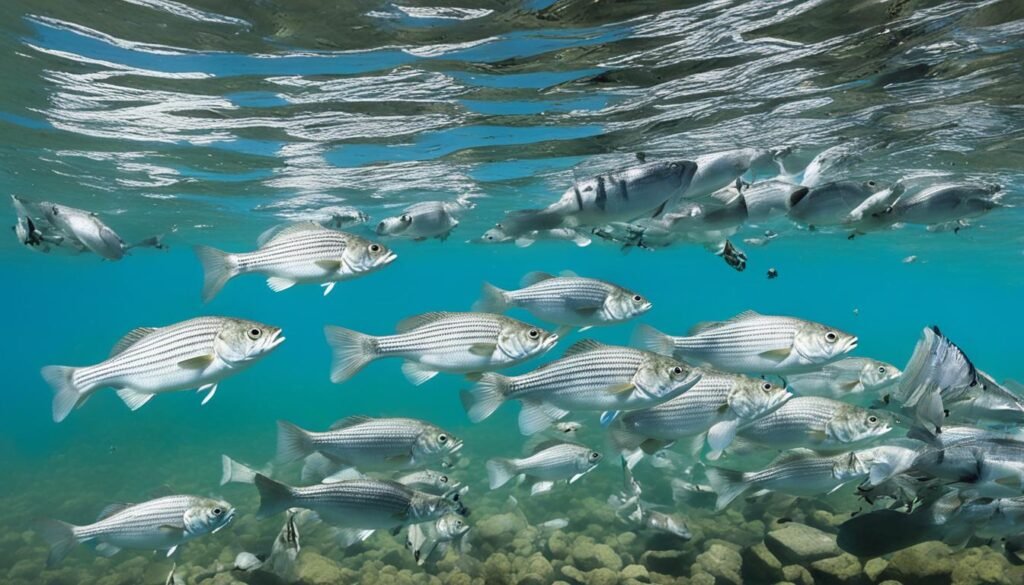Many experienced anglers in Canada love catching white bass. This is true even though it may not be the first choice for many. White bass are fun to fish for. They are strong fighters, taste great, and you can find them in many places.
Anglers often find white bass in schools across Canada’s lakes, rivers, and streams. They can fish for them all year. Whether it’s hot in summer or cold in winter, knowing where to look is key.
Key Takeaways about Fishing White Bass
- Pursuing white bass offers rewarding and consistent fishing experiences throughout Canada.
- White bass are known for their large school roaming behavior, making them detectable across various Canadian water bodies.
- Anglers can enjoy white bass fishing during all seasons with the right knowledge and techniques.
- White bass provide a delicious catch with light, flaky flesh akin to walleye.
- Understanding white bass behaviour and preferred habitats can significantly enhance your fishing success.
Introduction to White Bass
The white bass is highly valued by fishers in Canada. It is loved for its lively way of fighting and for being tasty. It is a small fish but very strong, belonging to the Moronidae family. It plays a big role in Canada’s fishing hobby. Knowing how to identify it is key, whether you’re just starting out or have been fishing for a while.
Overview of White Bass
A white bass overview shows it is normally 12 to 18 inches long. It usually weighs between 1 and 2 pounds. But, some can weigh over 5 pounds. This shows a big size difference. They are easy to spot by the arched back behind the head.
Characteristics and Identification
As a part of the Moronidae family, they like to swim in big groups. This is a common behaviour in tempurage bass species. Fishers often call them ‘whiteys,’ ‘sand bass,’ or ‘silver bass.’ They are enjoyed for their tender, white meat, similar to walleye. Fishing for white bass is fun because of this schooling. But, it’s also a challenge to catch them.
Best Seasons for Fishing White Bass

In Canada, the best times for catching white bass match their natural cycles. They spawn in the spring. Then, they feed avidly in the summer and fall. In the spring, white bass look for places to spawn. They like water that’s between 54 and 68 degrees Fahrenheit.
White bass live in changing environments. They love places like gravel bars and weedy areas for spawning. This knowledge helps fishermen catch more white bass throughout the year.
Knowing when and where to fish for white bass is essential. The table below shows the prime seasons for white bass. It also lists the best activities and how to catch them.
| Season | Activity | Optimal Strategies |
|---|---|---|
| Spring | Spawning | Target tributaries during spawning runs in structured environments like gravel bars. |
| Summer | Feeding | Focus on open waters where they are actively feeding on baitfish. |
| Fall | Feeding | Look for schools in shallow areas as they prepare for winter. |
Fishing at the right times boosts your success with white bass. It’s all about knowing when and where these fish like to hang out. This knowledge turns fishing for white bass in Canada into a thrilling and productive experience.
Ideal Locations in Canada
Canada has many top fishing spots. They are perfect for those who love to catch white bass. The country has vast lakes and rivers, each offering great chances to fish this lively type. This guide will highlight the best places and tips to make your fishing trips a success.
Top Lakes and Rivers for White Bass
Lake Erie and Lake Ontario are top picks for fishing white bass. They are known for their thriving white bass communities. Lake Simcoe is also great, especially during spawning season when white bass head to shallower areas.
The St. Lawrence River is a key spot too. It’s famous for its deep parts and rich life.
Regional Patterns and Trends
To catch more fish, you need to know about their habits. White bass often move towards the rivers’ starts for spawning in spring. This makes the best white bass habitats change during a season.
During spring, find where shad fish gather when it’s windy. Shad are what white bass like to eat, so where shad are, white bass might be close too.
Recognizing how nature and fish life are linked is vital for great fishing. With Canada’s many waters, there’s always a new spot to explore. This makes fishing in Canada a truly engaging experience.
Fishing Techniques for White Bass

Anglers have many choices when it comes to white bass fishing. You can use live bait, cast lures, or try fly fishing. Each method works well for certain situations and has its own benefits for catching white bass.
Live Bait Techniques
During spawning season, live bait rigging shines. It’s most effective when the bass are active. A setup with a weight, like a split shot, and a live minnow often gets bites. This method imitates natural prey, drawing the fish in.
Lure Techniques
If you love casting, using lures might be for you. There are many kinds of lures to pick from. Some mimic what white bass like to eat, encouraging them to strike. When white bass feed on the surface, using topwater lures is not only effective but also exciting.
Fly Fishing Approaches
For deeper waters, fly fishing is a good choice. It requires special gear and sinking lines. Anglers use flies that look like small fish. This approach is about mimicking the bass’s prey and making the flies look tempting to them.
| Technique | Key Elements | Advantages |
|---|---|---|
| Live Bait Rigging | Weighted rigs, live minnows | Natural bait movement |
| Lure Casting | Spoons, spinners, crankbaits, topwater lures | Versatile and engaging |
| Fly Fishing | Heavy gear, sinking lines, mimicking flies | Depth adaptation, aggressive strikes |
Essential Gear for White Bass Fishing
Getting ready for a great white bass fishing trip means having the best gear. The right fishing gear makes everything easier and more fun. It also helps you catch more fish. Here’s a look at what you need for white bass fishing.
Rod and Reel Recommendations
For white bass, use a medium-action rod. This kind of rod is flexible and sensitive. It works well with a 6- to 10-pound braid that’s tough and lasting.
Fly fishers should go for a 6 or 7wt rod. Add a sink line to go after fish that are deep. This setup is ready for any fishing style or situation.
Lines and Leaders
The line and leader you pick are key for catching white bass. Braid lines are a great choice because they’re thin but strong. A 6- to 10-pound braid is perfect here.
When it comes to leaders, go with fluorocarbon. It’s hard for fish to see and lasts a long time. This is especially good for clear water where white bass like to hang out.
Must-Have Lures and Baits
To catch white bass, you’ll need a mix of lures and baits. Include spoons, crankbaits, and topwater lures in your tackle box. These work well at different depths and conditions.
Choose baits that look like minnows and shad. These are key foods for white bass. Having live baits like nightcrawlers and minnows is smart too. This is especially true when white bass are spawning and looking for live prey.
Having the correct gear for white bass fishing is key. With the right rods, reels, lines, leaders, and baits, you’ll have a better fishing trip. You’ll be more ready to catch a lot of white bass.
Fishing White Bass During Different Seasons

Fishing for white bass is exciting but different each season. White bass tips for each season really help improve your catches. They give you the right tactics for every part of the year.
In the spring, white bass spawn and are easily caught. They move to shallow areas near tributaries. You can use live minnows and worms to catch them.
During the summer, white bass are active on the surface. They chase after baitfish. Using lures that look like shad early in the morning and late at night is your best bet.
In the fall, white bass come close to shore, making them easier to catch. Casting crankbaits and jerkbaits into shallow waters works well.
Winter fishing for white bass is tough. They’re not very active and stay in deep water. To catch them, use heavy jigs and spoons. With the right white bass tips, you can keep catching them even in cold weather.
To catch white bass all year, understand their changing behaviours. Adjust your equipment and fishing methods for each season. This will ensure your fishing trips are both fun and successful.
| Season | Key Strategy | Effective Bait |
|---|---|---|
| Spring | Spawning areas focus | Live minnows, worms |
| Summer | Topwater action | Topwater lures, shad replicas |
| Fall | Shallow water casting | Crankbaits, jerkbaits |
| Winter | Deep water jigging | Heavy jigs, vertical spoons |
Understanding White Bass Behaviour

Learning about how white bass behave is crucial for fishing success. They show specific movements when it comes to eating, laying eggs, and moving from place to place.
Feeding Habits
White bass are aggressive feeders, going after shad fish mainly. They eat a lot, so they’re often seen near schools of these fish. Anglers can take advantage of this by fishing early in the morning or at dusk when white bass are most active.
Spawning Patterns
In spring, white bass lay their eggs when the water is between 54 to 68 degrees Fahrenheit. They do not build nests. Instead, they drop their eggs on rocks or plants where they stick until they hatch. Anglers should focus on places with these substrates during the spring.
Migration and Schooling
Migration is key for white bass. They move upstream to spawn in spring and then go back to deeper waters after. In schools, they offer anglers many chances to catch fish. It’s important to know when and where they will be, based on the temperature and food available.
Safety and Conservation Tips
It’s crucial to keep the waters and fish populations healthy when you fish. By following safety and conservation tips, you make fishing better for yourself and help keep fish homes safe. This is important for the future of fishing.
Catch and Release Best Practices
When you catch a fish and let it go, do it the right way. Use hooks without barbs to not hurt the fish as much. Wet your hands before handling them so their slime coat stays on. Make sure the fish is strong before you let it swim off. This way, it has a better chance of staying alive.
Environmental Conservation
To help the environment, don’t catch more fish than you should. Learn why white bass are important in their homes. This helps you make choices that help keep different plants and animals alive. Also, keep fishing spots clean and try not to bother the water’s natural balance.
“Effective conservation strategies extend beyond individual actions, encompassing community efforts to protect and restore fish habitats. By engaging in responsible angling, each angler contributes to a sustainable future for white bass and other aquatic species.”
Conclusion
Fishing for white bass in Canada is more than just catching fish; it’s about exploring and learning. Seasons are key to successful fishing, from spring’s spawning to winter’s deep waters. Each time of year brings its own challenges and joys, making the fishing journey richer.
Learning different fishing styles, like using live bait or lures, makes fishing more fun. It also helps increase your catch. Growing through experience shows that you should always be learning and changing when fishing for white bass.
Respecting nature and caring for it is crucial for fishing to last. Anglers who know the seasons, improve their skills, and protect the environment truly understand white bass fishing. These efforts make fishing more rewarding and help safeguard Canada’s fishing future for others.
Discover detailed information and practical tips for targeting specific fish species in Canada on the Fishing for Specific Species page.
Learn about the best techniques, suitable baits, and ideal fishing spots to increase your chances of a successful catch. Whether you’re a beginner or an experienced angler, this guide offers valuable insights to enhance your fishing experience.
FAQ about Fishing White Bass
What is white bass and where can it be found in Canada?
White bass are part of the Moronidae family, known for their small size and aggressive nature. They are found in Canadian lakes, rivers, and streams, and migrate widely.
When is the best time to fish for white bass in Canada?
The best times are spring for spawning and summer/fall for feeding. They spawn in 54 to 68 Fahrenheit water.
What are the top fishing locations in Canada for white bass?
Key locations are lakes and river systems that the white bass move through. They follow shad populations and go upstream to spawn.
What fishing techniques are effective for catching white bass?
For spawning times, try live bait rigs. Use spoons, spinners, and crankbaits when they’re feeding. Fly fishing is also effective with strong gear.
What gear is essential for white bass fishing?
Use medium-action rods with 6- to 10-pound braid lines. Fly anglers, use 6 or 7wt rods. Make sure to have the right bait, like minnows.
How do white bass behave seasonally?
They spawn in spring, feed on baitfish in summer, are aggressive in fall, and group in winter. Adapt your fishing style to each season.
What are the defining characteristics of white bass?
White bass are 12 to 18 inches long, usually weighing 1 to 2 pounds. They travel in big groups and have tasty, light, and flaky flesh.
Why is understanding white bass behavior important?
Knowing about their habits, like liking shad and migrating, helps anglers find and catch them. Weather, like wind, influences where they go.
What are some conservation tips while fishing for white bass?
To protect these fish, use barbless hooks and handle them gently. Follow creel limits and help keep their environment clean.


